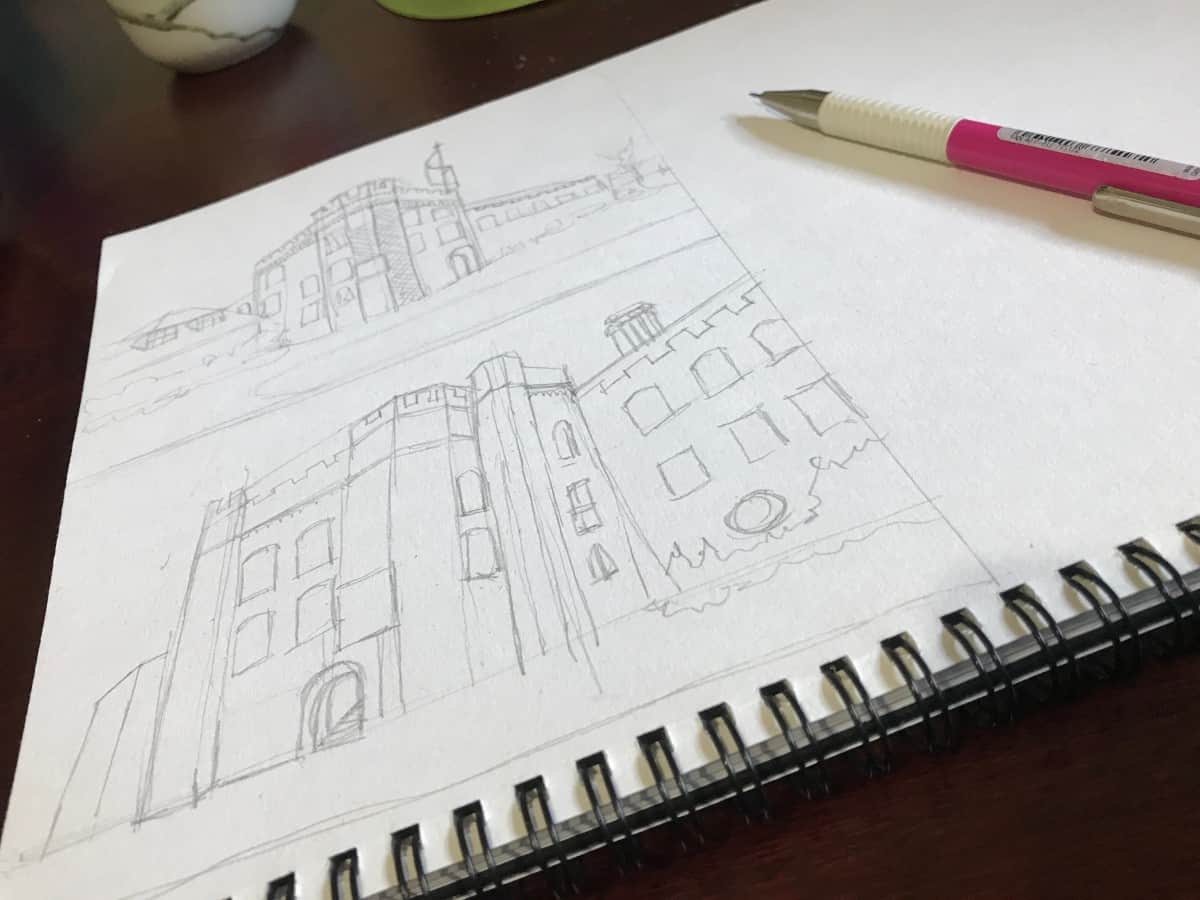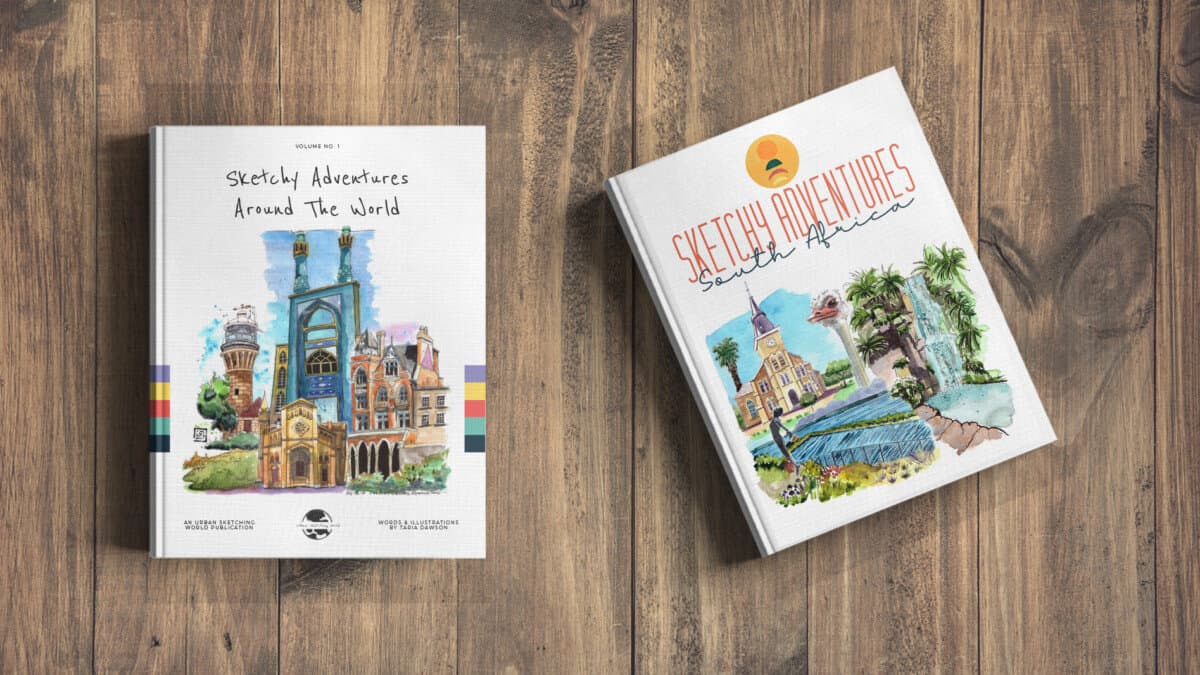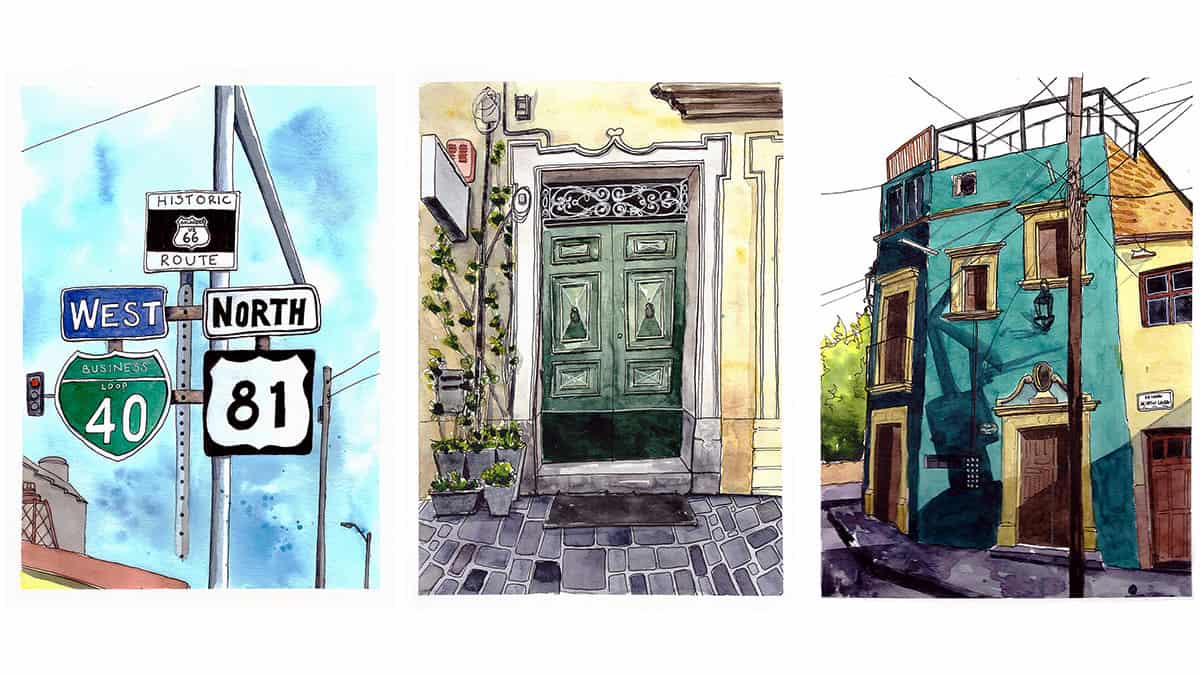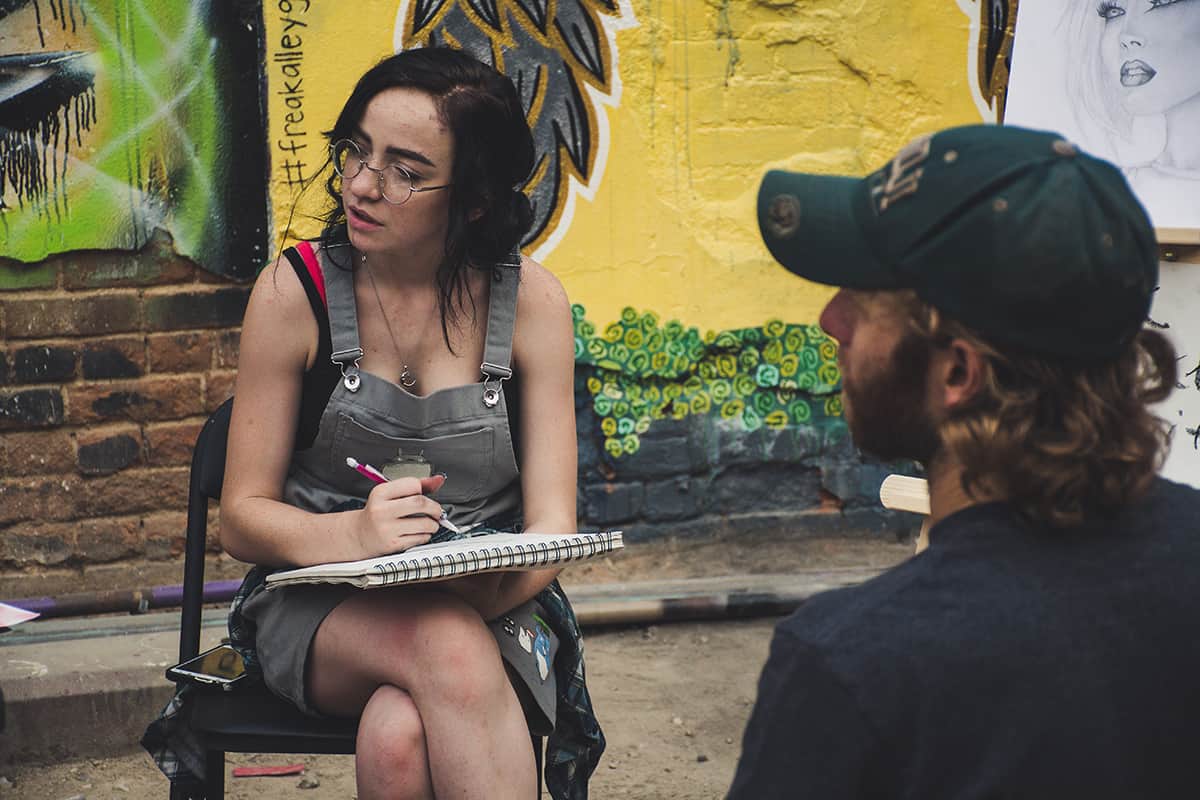Whether you are new to urban sketching or have a good deal of experience, thumbnail sketching can be a worthwhile technique for improving the quality of your work. Thumbnail sketches allow you as the artist to experiment with the composition and perspective of a scene, modifying factors to help you give a larger sketch that you may spend a few hours on the right feel.
Thumbnail sketching can help perfect your ability to produce satisfying urban sketches. But why should you take the time to make thumbnail sketches, and how do you go about it?
Why and How to Make Thumbnail Sketches when you’re Urban Sketching:
- Why:
- Serves as A Quick Warm-Up
- Helps You Determine the Composition of a Piece
- Helps You Remember Important Features
- Helps You Perfect Your Proportions
- Helps You Eliminate Perspective Errors
- Helps You Determine the Best Use of Shadow and Colour
- How:
- Divide Your Page into Several Small Sections
- Draw Several Iterations of the Same Scene
- Simplify by Using Only One Medium
- Experiment with Values or Color Themes
How Thumbnail Sketches Saved Me Hours
The process of using thumbnail sketches has saved me some major problems recently when working on two separate commissions for two different clients. It got me thinking that this process is equally vital to urban sketching too. Thumbnails can be extremely helpful if you are intending on spending a significant amount of time on creating any piece of art.
I produced a rough sketch for my first client and his response was “oh, that’s interesting”.
I asked him what he meant.
“I just envisioned the piece as being in a portrait orientation”.
I had sketched it in a landscape orientation. My rough sketch also prompted some other very specific things he wanted from the final version that had not been discussed in the initial brief.
If I had not done the rough sketch before jumping into the final piece, I’m fairly certain I would have delivered something to him he would not have been happy with.
For the second client, I did a series of thumbnails and had chosen one of them to work up a bit further with colour and more detail. The client had initially given me a few photos of the building he wanted sketching from different angles and then said I could find more photos on the internet if I needed. To me, this meant he didn’t really have a preference which angle I sketched the building from.
After sending him the rough sketch of the building from the angle I had chosen to work on, he said: “oh, do you have any sketches of the other angles”?
I showed him the very basic pencil sketches of the other angle. He said, “can you paint it from that other angle as that’s the one I wanted”.
Firstly, in my head, I thought why didn’t you tell me that in the first place (!) and secondly I am so glad that I did some rough sketches and again did not launch into the final version. I saved a lot of time.

Why Should You Make a Thumbnail Sketch for Urban Sketches?
There are several reasons for making a thumbnail sketch for your urban sketches, and if you take the extra step to experiment with thumbnails, you may very well find yourself liking the results of your full-scale sketches even better.
Many artists have found the value in producing thumbnails when creating their work, and urban sketching is no different. If you aren’t convinced that thumbnail sketches are worth your time, read on to find out just why these little planning sketches can be so helpful.
1. Thumbnail Sketches Serve as a Quick Warm-up
Just as a basketball player would stretch and shoot a few baskets before a game in order to get loose, an artist can benefit from a short warm-up session before engaging in a larger sketch that may take several hours. Thumbnail sketches can be thought of as a technique for getting your head in the right creative space for your work and warming up your skills.
For urban sketching, thumbnails can be a helpful method of collecting ourselves and gearing up for a drawing session. Many times, with urban sketching, you may pause to draw in the middle of a bustling day or after travelling for some time to reach your sketching location. Thumbnails are a great way to recenter your focus and concentrate on the sketch, rather than all the other distractions that could be floating through your mind just prior to drawing.
>> Check out my post on urban sketching as a mindfulness technique <<
Urban sketching frequently concentrates on capturing a moment or the essence of a place. This can require a particular amount of alertness, which can be built up with a few quick thumbnail sketches to awaken your senses.
2. Thumbnail Sketches Help Determine the Composition of a Piece
Arguably one of the biggest advantages of a thumbnail sketch is that it lets you avoid a lot of future frustrations and erasing by helping you plan out the composition of a piece before you start in earnest.
If you study many of the great Renaissance artists such as Raphael, Michelangelo, and Leonardo da Vinci, you’ll find that for many of their most famous works of art, they have countless sketches and studies leading up to the final piece. Michelangelo, for his famous Creation of Adam on the Sistine Chapel, has numerous sketches representing different iterations of simply the hands in order to determine the ideal position.
From these masters, we can learn that thumbnail sketches help to plan a more involved sketch, even if you don’t intend for them to be quite as expansive as the Sistine Chapel. You may find while drawing a thumbnail sketch that your intended subject is too crowded, or at a poor angle. The thumbnail sketch lets you realize this and modify it before you’ve wasted countless hours drawing or painting it in detail.
With urban sketching, don’t be afraid to play around with your composition. Recognize how variations in layout can pull the eye in different directions. Does your sketch feel like it has a balance between objects and space?
A thumbnail sketch can let you quickly see if your desired subject needs to be modified or if you need to add or remove elements for the best final product. This can save you a lot of headaches later in the sketching process, even if you’re only planning a small piece.
3. Thumbnail Sketches Help You Remember Important Features
When you start making thumbnail sketches, you will invariably find yourself being attracted to certain details and consistently reiterating them in the thumbnails. In your urban sketching, it may be the scrollwork on an iron streetlamp, or the pensive face of a cafe patron, or the decaying arch of a city walkway.
As you draw several iterations of these features, you will start to memorise them. Embedding these details in your memory can help you draw them in your full-scale sketch, especially if your subject happens to wander off in the middle of your sketching (we’re looking at you, pensive cafe patron.)
4.. Thumbnail Sketches Help You Perfect Your Proportions
An important consideration in any type of visual art is the proportions. Proportions can not only help make your work feel balanced, but it can also make it more expressive through careful use of scale. Studying the relationship between sizes and shapes can help you truly capture your intended scene.
Proportions can be deceptively tricky. If you start too small, you may find your scene not filling the whole space. Too large, and you may end up cropping out important features or squashing things in at the edges. Thumbnails can help you plan out how much space each element needs to fill in order to utilise the entire sketching space.
Urban sketching frequently features a complex assortment of subject matters. We are not sketching carefully arranged still-lifes. Instead, we are often capturing a moment or a particular space, with no control over the elements involved (which is why it’s so fun). As such, it can be helpful to do a few quick thumbnail sketches to make sure we can accurately capture all the varying proportions and make sure they are in harmony with each other.
You can also use thumbnail sketches to experiment with proportions. Perhaps you feel you have accurately captured the proportions in a quick thumbnail, but you don’t feel the sketch gives the impression you desired. For example, perhaps you want to emphasise how the greenery in a city park is being overshadowed by the urban development around it.
You could try scaling down the trees and shrubbery of the park and slightly overemphasise the proportions of the surrounding buildings and powerlines. Proportions and scale can be tweaked if you are looking to convey a particular sensation, thumbnails can help you home in on this expression.
Check out my ebooks with hundreds of ink & watercolour travel sketches from all over the world. Get some inspiration for your next trip…

5.. Thumbnail Sketches Help Eliminate Perspective Errors
Perspective can occasionally be tricky to capture accurately. Thumbnail sketches can help you avoid common mistakes in perspective in your full-scale sketch. A proper perspective is critical in order to create the illusion of depth and space in your work.
If you want to give your sketches a sense of realism, perspective is crucial. Perspective needs to be applied consistently throughout the whole work, and you may have to correct certain areas as you progress. Thumbnail sketches can help you recognize areas that may be particularly tricky and require careful consideration.
The common expression of “practice makes perfect” definitely applies to perspective. Thumbnail sketches give you some chances to practice the perspective in quick, risk-free doodles before investing much more time and effort in the full-scale representation.
Thumbnail sketches can also help you determine what point of view you would like to use for your urban sketch. Depending on your viewpoint, you might find in a thumbnail sketch that you are unsatisfied with the location of your horizon line or your vanishing point.
These thumbnails can help you determine whether you need to change your location in order to achieve a more appealing perspective before you spend a long stretch of time working on a large sketch.
Do you want to learn how to sketch your own adventures in ink & watercolour?
GET 50% OFF FOR A LIMITED TIME ONLY!!
I will show you my exact sketching process in ink and watercolour. I have travelled around the world in the last 3 years and this is my go-to system of creating beautiful yet quirky illustrations to capture the magic of my discoveries.
We will work through 3 projects, step by step (pictured below), all of which are real-life examples of things I have sketched along my travels. I provide the photo references you can work from.
We will start by choosing a composition, laying in the initial pencil sketch, adding ink lines, layering watercolour and adding the final touches.
This and much more are included in my course, Sketch Your Adventures, click the button under the image to find out more!

6. Thumbnail Sketches Help You Determine Shadows and Potential Color Variations
Depending on your preference, some urban sketchers work with only a pencil or pen while some prefer a small watercolour set or pastels. Thumbnail sketches can help you determine the best application of your preferred medium.
If you work in monochromatic mediums like graphite or ink, thumbnail sketches can help you determine the appropriate value levels. Where is the darkest area in your subject, and how will you grade your shadows based upon it? Which area will be so light of a highlight that you may not even touch your pen to paper?
Thumbnail sketches can help you play with your shadows and determine how dark or light you want the overall sketch to appear. If you are working in a permanent medium like ink, this can be incredibly helpful, especially if you consistently feel like your full-scale sketches are always much darker looking than you desire.
Thumbnail sketches can also help you play with colour themes. While many thumbnails are usually monochromatic studies, if you are working with colour it can be useful to incorporate some simple colour planning into your thumbnail.
Try playing with a few different colour variations and see what best captures your interpretation of the scene. You might surprise yourself and find yourself favouring a colour scheme you had not originally considered for your work. Thumbnails can be a useful, risk-free way to test out ideas and find the best combination for your full-scale sketch.
How Do You Make a Thumbnail Sketch for Urban Sketching?
Now we have recognised the value of thumbnail sketches, lets discuss how we can get started using them. Learning to thumbnail sketch is fairly easy and can be accomplished in a few steps. It’s learning to get in the habit of doing it that takes the work.
1. Start by Dividing Your Page into Several Small Sections
In order to start making thumbnails, you need to make a space in which to draw them. Contrary to the name, thumbnail sketches are rarely actually the size of thumbnails. Instead, they are usually a few inches by a few inches, enough space to fit your scene but not large enough to permit precise detailing.
Your thumbnail sections will likely vary in size depending on the size of your drawing pad. If you are working on an A4 size (or 8.5 by 11 inch) sketch pad, you may divide your paper vertically down the centre and then two to three times horizontally in order to create six to eight panels. If you are sketching on a napkin, that is usually small enough to already be the right size for a thumbnail sketch, and you probably don’t need to divide it further.
Try to make sure your thumbnail sketches are all relatively similar in size in order to be able to accurately plan your perspective and composition. If you have a particular detail you choose to draw a few times, that’s fine, but try to use at least a few thumbnails to plan the overall sketch layout.
2. Draw Several Thumbnails of the Same Scene
It may be tempting to draw a different subject in each thumbnail, but in order to best utilise thumbnail sketches as an aid, you should draw several iterations of the same scene.
You do not have to strictly repeat the exact same details in each thumbnail, however. Use the thumbnails to experiment with composition and perspective. If you find in the first thumbnail that the scene seems too crowded, try eliminating a few elements in the next thumbnail and determine whether you have achieved a better balance without losing the intended overall feeling of the sketch.
If you are drawing people, you may play around with the expressions on their faces, or how they are posed from thumbnail to thumbnail. In general, the thumbnails keep the same essential theme permeating throughout them but with minor variations and tweaks to help plan the full-scale sketch.
3. Try to Simplify Thumbnail Sketches by Using Only One Medium
While you may intend your final, full-scale sketch to utilise multiple mediums and colours, it can be helpful to try to focus on keeping thumbnail sketches minimalistic and simple. Thumbnail sketches are meant to capture a general idea and help plan a full-scale sketch, not to be perfect recreations of scaled-down versions of the large sketch.
In order to help simplify the thumbnails and keep you from being tempted to lay down too much detail, try to only use one medium. Pen and pencil are often ideal for thumbnail sketches, as the monochromatic medium keeps you focused on the goal of perfecting perspective and composition rather than getting distracted by varying hues.
While you may devote a particular amount of attention to a specific detail of a scene in your thumbnails, the overall idea of the thumbnail is to help you get the general gist of the scene before you sit down to attempt a much more time consuming, elaborate sketch.
Try to avoid going into too much detail and don’t get hung up on creating perfect representations. Most artists will only spend three to ten minutes per thumbnail sketch. Thumbnails permit you the freedom to map out an idea without critiquing your technique, letting you explore various concepts and ideas.
If you do decide to use multiple mediums or incorporate colour into your thumbnails, try to keep it minimalistic and simple. Use just enough colour to convey an idea or test a concept, but not so much that you get bogged down with the nuances of it.
4. Experiment with Different Values and Colour Schemes
One of the main advantages of thumbnail sketches is that they allow a risk-free way to experiment with the values and colour theme of your work. As you work from thumbnail to thumbnail, you can use variations of shadows and colour to determine the best combination for your final sketch.
Varying levels of shadows can give a vastly different feeling to a piece of work. Stark variations in contrast can give a more flat but stylized interpretation of a scene. Conversely, a more gradual, gradient shift in shadows can give a work a softer, more realistic appearance. Thumbnails can help you determine the right balance of contrast in order to achieve your desired scene.
If you work with coloured mediums like watercolours, coloured pencils or pastels, thumbnails can help you determine what hues will look best for your urban sketches. Do you want to capture the real essence of the scene with vibrant, true to life pigments? Or perhaps you want to shift the temperature of the scene, emphasising the cool blues of a fountain or the warm oranges of a July sunset in the concrete sprawl of a downtown city block.
Colour can quickly change the feel of a piece. Incorporating colour into your thumbnail sketches can help you determine the best way to utilise colour to convey the scene as you want it to be seen.
Usually, it is best to keep the colours in the thumbnails minimal and simple, so as to avoid getting into too much detail on the small scale. Think of the colours used as a quick gesture, enough to give an idea of sentiment but not elaborating the full scope of the idea.
Some of my favourite online classes
- Urban Sketching: Express Your World in a New Perspective – Lapin
- Travel Illustration: Recreate Your Favourite Place – Alex Green
- Sketchbooking For Beginners: Learn to Draw Your Surroundings – Maximilliano Vera Herrera
- Exploratory Sketchbook: Find Your Drawing Style – Sarah Van Dongen
Thumbnail Sketches Can Be A Valuable Asset for Urban Sketching (and Commissions)!
Whether you are just starting out or have been drawing for years, thumbnails can help improve your drawing techniques and result in better full-scale sketches. These rough sketches can help lead to a polished final concept through a risk-free process of trial and error.
It is worth the bit of extra time it takes to sketch out a few thumbnail sketches before you attempt a larger piece of work. Thumbnail sketches can help save you from realising too late in the process that you’ve chosen a poor perspective or an unappealing colour palette. Experiment with thumbnail sketches, and you will no doubt find yourself pleasantly surprised with your resulting work.
So, in conclusion, thumbnails rock. Especially if you’re planning on spending a couple of hours on your sketch.
For more information on improving your urban sketching skills in general, check out my post here.
If you enjoyed this post, please do check out the rest of the website for more urban sketching chatter. Also, come say hi on Instagram @urbansketchingworld or for a longer conversation there’s good ol’ fashioned email: taria@urbansketchingworld.com

